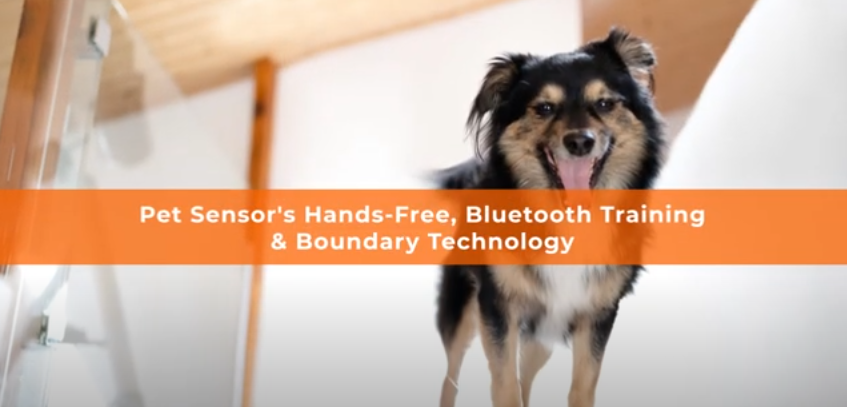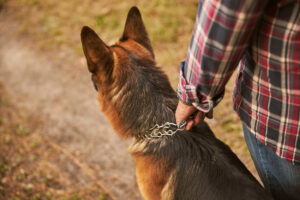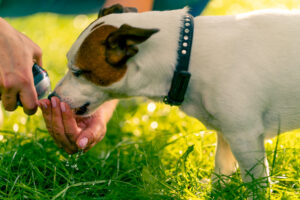
Are Electric Dog Training Collars Safe?
Training tools for dogs often spark debate, and few stir as much discussion as the e-collar. Some people see it as a harsh corrective device that causes unnecessary discomfort, while
GET YOUR DOG COLLAR TODAY! FREE SHIPPING FOR A LIMITED TIME!
Pet Sensor “Barriers Without Confinement”
Indoor Dog Behavior Training System
With the wireless, Bluetooth dog e-collar solutions from Pet Sensor, you’ll be equipped with an easy-to-use indoor dog training tool to help train your dog to stay away from certain areas within the home, as well as keep them under control when guests are present and more.
Pet Sensor was inspired and developed to provide pet owners with a more effective way to teach pets in smaller spaces (homes, condos, apartments, etc.) where they can and can’t go. Keep your four-legged friend off the couch, or out of the bedroom hallway, with our user-friendly, convenient, and compact fob dog e-collar.

Regardless of your pet’s temperament, the PSSD enables you to customize solutions for your pet based on their specific needs. An adjustable electronic stimulation tool gives owners the most comfortable correction solutions for their pets.
One of the foremost advantages of Pet Sensor is that it’s so easy to implement. It’s intended for indoor use (or use in smaller spaces), meaning no complicated electrical wiring installation and our Bluetooth fobs are compact and can be hidden out of sight.
The PSSD provides custom notifications for you and your pet when they approach a connected boundary. The dog e-collar alerts your pet to return to safety using a painless combination of buzzing, beeping, and subtle electrical stimulation to keep them obedient whether you’re home or away from the house.

Trustindex verifies that the original source of the review is Google. Product works incredibly!Posted onTrustindex verifies that the original source of the review is Google. As a devoted dog owner, I've found Pet Sensor to be a revolutionary solution for my home. Traditional dog gates were a nuisance and stressed my dog, but Pet Sensor's virtual boundaries are a perfect, personalized fit for our space. It's evident that a true pet lover created this product. Now, my home is hassle-free, my dog is content, and we're both enjoying a more relaxed environment. I highly recommend Pet Sensor to any pet owner looking for a convenient and effective way to keep their pet safe.Posted onTrustindex verifies that the original source of the review is Google. As a proud dog dad and someone who's always looking for the best for my furry friend, I can honestly say that Pet Sensor has been a game changer for us. I used to struggle with setting up those cumbersome dog gates and other physical barriers around the house, which was not only a hassle but also seemed to stress out my pup. That's when I found Pet Sensor, and y'all, it's like they knew exactly what we needed. The virtual boundary installation is not just unique; it's personalized to fit the needs of my dog and my living situation. It's clear that this company was founded by someone who truly understands the love between a pet and their owner, and they've created a product that reflects that. Now, I can live comfortably in my home without constantly tripping over gates or worrying about my dog getting into places he shouldn't. And the best part? My dog is happier and more at ease, too. We've found our rhythm, and it's all thanks to Pet Sensor. So, if you're on the fence, take it from me: give Pet Sensor a try. It's made a world of difference for us, and I know it can do the same for you and your furry family member.Posted onTrustindex verifies that the original source of the review is Google. Love the product, my dog learned vey quick not to jump in the sofa even when I'm not home. It took only a couple of repetitions and he picked up quickly (3 Year old Weimaraner). Now even with out batteries, he stays away from the sofa.

Training tools for dogs often spark debate, and few stir as much discussion as the e-collar. Some people see it as a harsh corrective device that causes unnecessary discomfort, while

Training a stubborn dog can test even the most patient owner. Whether it’s a young dog ignoring boundaries within your home or a herding breed chasing distractions, some dogs seem

When it comes to effective and humane training, many dog owners ask one question: What’s the right way to use an e-collar? While this tool can be a powerful communication
Indoor dog training is the essential process of teaching dogs obedience and desirable behaviors within the controlled environment of your home. It is critically important because it directly addresses and helps prevent common issues such as house soiling, destructive chewing, and excessive barking.
By providing a consistent routine, you create a structured learning environment. Tools like an indoor dog fence can help manage space and establish clear boundaries during this foundational phase. While some may eventually consider more advanced methods like e-collar dog training for off-leash reliability, mastering commands indoors is the first step. This foundational training, sometimes supplemented with tools like a Bluetooth dog collar for containment, builds the confidence and focus needed for success in more distracting outdoor settings.
An electric dog training collar works by delivering a mild, adjustable stimulation, often a vibration, sound, or static pulse, to interrupt a dog’s focus and redirect it from unwanted behaviors. This method of e-collar dog training is primarily used to correct actions like excessive barking, jumping, or ignoring commands during an indoor dog training session.
When used responsibly, modern collars are safe. They feature multiple intensity levels, allowing owners to use the lowest possible setting to get their dog’s attention. For example, a collar might be used with an indoor dog fence system to provide a vibration cue when a boundary is approached. It is crucial that the collar is used as a tool to communicate, not to punish. For effective and humane training, its use should always be paired with positive reinforcement, such as praise or treats, once the dog complies.
While both systems are used for containment, the main difference lies in how they establish boundaries. A traditional electric fence dog collar works with a physical wire buried underground. The collar delivers a correction when the dog crosses this specific, customizable perimeter. This system is precise and can be shaped to fit any yard.
In contrast, a wireless boundary collar, often used as an indoor dog fence, operates with a central transmitter that creates a circular “”stay zone.”” Both collars are tools used in a broader training approach, which might also include indoor dog training for obedience or more advanced e-collar dog training for off-leash commands. Both systems effectively teach a dog its limits, keeping it safely contained within a designated area.
Yes, an indoor dog fence is an invaluable tool for puppy training and is a core component of a successful indoor dog training program. By using a physical dog fence indoors, such as a portable gate or playpen, you can limit a puppy’s access to certain areas. This containment strategy is highly effective for preventing potty accidents around the house and stopping a puppy from chewing on furniture or electrical cords.
For a more modern approach, Bluetooth indoor boundary systems, which use an e-collar, can create “”no-go”” zones around specific objects or rooms. These simple containment tools are perfect for establishing rules and routines with young puppies, making the training process much easier and more effective.
It is generally recommended to wait until a puppy is at least five to six months old before starting any form of e-collar dog training. A puppy’s brain is still developing, and it’s crucial that they first understand basic commands like “sit,” “stay,” and “come” through positive reinforcement.
Introducing a collar too early can cause confusion and anxiety, hindering the learning process. Successful indoor dog training builds the necessary foundation. Once a puppy is old enough and has mastered these basics, an e-collar can be introduced on its lowest setting. For example, a Bluetooth dog collar can help teach boundaries. The stimulation should only serve as a cue to get the puppy’s attention, not as a punishment, and must always be paired with praise for correct behavior.
When used correctly, an e-collar is not cruel. The controversy and concerns about cruelty almost always stem from misuse, such as using excessively high settings or relying on the collar as a form of punishment instead of a communication tool.
Modern devices used in e-collar dog training are designed to startle or get a dog’s attention with a mild sensation, not to cause harm. Whether for indoor dog training with an indoor dog fence system or for off-leash work, the collar should be used on the lowest effective setting. Responsible training focuses on pairing the collar’s cue with a command and rewarding the desired behavior. The goal is communication, not correction, making it a safe and effective tool in the right hands.
For safe indoor dog training, using an e-collar dog training device with the proper fit is crucial. The collar should be snug, but not so tight that it restricts your dog’s breathing. A good rule of thumb is to ensure two fingers can comfortably fit between the collar and the dog’s neck. A collar that is too tight can cause skin irritation, while one that is too loose may not deliver consistent or proper correction. You should also regularly check your dog’s skin for any signs of sensitivity or irritation, especially when using an indoor dog fence system.
Introducing your dog to an e-collar should be a slow and positive process. Start by having your dog wear the collar for short periods around the house without ever turning it on. This is a crucial first step in any e-collar dog training plan. Associate the collar with positive experiences by giving treats, praise, and playing their favorite games while they have it on.
After a few days of this conditioning, you can begin your indoor dog training by introducing a very low-level stimulation, just enough to get their attention, while practicing a command they already know. Whether using it for obedience or with an indoor dog fence system, the goal is for the dog to associate the sensation with a command, not punishment. Consistency, patience, and positive reinforcement are key to success with any e-collar.
E-collars and boundary collars are very effective for reinforcing obedience when used as part of a structured training plan. The success of any e-collar dog training program hinges on consistency and using the correct, low-level settings to communicate with, not punish, the dog.
For obedience, these collars can sharpen commands like recall (“”come””), sit, and stay, especially during off-leash activities where verbal commands might be ignored. An e-collar, used with a system like an indoor dog fence, is highly effective for teaching boundary control and keeping pets out of certain areas. The effectiveness of these tools is directly tied to the quality of the initial indoor dog training, where the dog learns to associate the collar’s cue with a specific command or boundary, followed by praise for compliance.
While the terms are often used interchangeably, there is a key difference. An electric fence dog collar specifically refers to the collar that works with a physical, underground wire that you install to create a boundary. The collar activates only when it detects the signal from that specific wire.
“Invisible fence” is a broader, often brand-associated term for the entire category of electronic pet containment, which includes these wired systems as well as wireless ones. For instance, a wireless dog fence indoor that uses a Bluetooth transmitter instead of a wire is also a type of invisible fence. This broader category can even include advanced GPS systems. Therefore, while an electric fence dog collar is part of an invisible fence system, the term also covers other technologies used in both indoor dog training and e-collar dog training for containment.
The best dog training equipment varies based on your specific goals, but a combination of tools is often most effective for both indoor and outdoor scenarios.
For indoor training, an indoor puppy fence is essential for creating safe, managed spaces, while clickers and treat-dispensing toys are excellent for positive reinforcement. For outdoor training and off-leash reliability, an e-training collar can be very effective for reinforcing commands like recall from a distance. A wireless dog boundary collar system is a great choice for establishing containment zones in your yard without physical fences. Ultimately, the right equipment depends on your dog’s temperament and what you aim to achieve, from basic house manners to advanced obedience.
A wireless dog boundary collar system is a popular piece of modern training equipment that creates a safe containment area without physical fences. The system works with a central transmitter that plugs into an outlet and emits a radio signal, creating a circular “stay zone.”
Your dog wears a special receiver collar, which is a type of Bluetooth dog training collar. As the dog approaches the edge of the boundary, the collar issues a warning tone or vibration, followed by a mild static correction if they continue. This technology is considered some of the best dog training equipment for open yards and indoors because it’s easy to set up and portable. Unlike a physical indoor puppy fence, it provides an invisible barrier, giving your dog freedom while ensuring their safety.
Yes, using a puppy fence indoors is an excellent way to keep your dog safe and contained, especially during the puppy stage. It’s considered one of the best dog training equipment essentials for house management.
By using a playpen or portable gates, you can restrict your puppy to a designated safe zone. This prevents common problems like potty accidents in unwanted areas, chewing on furniture or cords, and accessing unsafe rooms. This structure is crucial for effective potty training. For a more modern approach, you can use a dog boundary system indoors, which uses a Bluetooth dog training collar to create invisible “”no-go”” zones. Both physical and electronic options provide peace of mind while your puppy learns the rules of the house.
Compared to other training tools, the primary benefit of a Bluetooth dog training collar is its ability to provide immediate feedback to interrupt an unwanted behavior, even from a distance. This makes it highly effective for off-leash recall and obedience, where a leash or verbal command might fail.
As one of the best dog training equipment options for advanced training, its adjustable stimulation levels allow you to customize the correction to your dog’s specific temperament. While an indoor puppy fence provides physical containment, a Bluetooth collar teaches behavioral boundaries. For balanced and humane training, the collar’s correction should always be paired with positive reinforcement once the dog complies.
Yes, a wireless dog boundary collar system is safe and comfortable for dogs when used as intended. These collars are designed to be lightweight and adjustable to ensure a proper fit for various breeds and sizes.
As a specific type of electric dog training collar, its safety lies in its adjustable correction levels. Most training can be accomplished using just the audible tone or vibration settings. The static correction, when needed, is mild and designed to startle, not harm. It is considered one of the best dog training equipment options for containment. While a physical indoor puppy fence creates a visible barrier, a wireless Bluetooth collar creates an invisible one. Cruelty concerns only arise from misuse, such as improper fitting or using excessively high settings, not from the device itself.
Choosing the right electric dog training collar is crucial for effective and humane training. The most important factor is selecting a model with adjustable intensity levels that are appropriate for your dog’s size and temperament.
For small breeds, the best dog training equipment will be a lightweight collar with very gentle stimulation options. Larger, more muscular breeds may require a collar with a stronger signal and longer contact points to ensure they can feel the sensation through their coat. Whether you’re choosing a general training collar or a Bluetooth dog boundary collar, ensure it fits comfortably and securely. Unlike a simple indoor puppy fence, an e-collar’s effectiveness and safety depend entirely on a proper, customized fit for your specific dog.
To be effective, the best indoor puppy fence should have several key features. Look for sturdy, chew-resistant materials to ensure it’s durable. Adjustable panels are crucial, allowing you to change the size and shape of the enclosure as your puppy grows or your needs change. Portability and easy-to-clean surfaces also make management much simpler.
A good fence should be tall enough to prevent your puppy from jumping over it, and an integrated door provides convenient access for you without having to step over the barrier. While tools like a Bluetooth dog boundary collar system, which uses an electric dog training collar, offer electronic containment, a physical fence is often the best dog training equipment for safely managing a young puppy’s environment.
A Bluetooth dog training collar is a powerful tool for reinforcing obedience commands, especially in distracting outdoor environments. It excels at providing a consistent and immediate correction when verbal cues for commands like “”come,”” “”sit,”” or “”quiet”” are ignored, making it highly effective for off-leash training.
Considered one of the best dog training equipment options for reliable control, its purpose is to get a dog’s attention so you can redirect them to the correct behavior. Unlike an indoor puppy fence, which provides physical containment, or a wireless dog boundary collar, which teaches spatial limits, this collar actively sharpens commands. For the most effective and humane results, it should always be used on a low setting and combined with positive reinforcement like praise or treats once the dog complies.
Yes, a wireless dog boundary collar is suitable for most dogs, from small to large, as long as you choose the right model. The best dog training equipment is never one-size-fits-all.
Most modern collars are adjustable, but the key is to match the unit’s specifications to your dog. Small dogs require a lightweight collar with very low, gentle stimulation levels. In contrast, larger breeds need a collar with a stronger signal range for reliable boundary detection and more durable construction. This type of electric dog training collar is designed for containment, unlike a physical indoor puppy fence. By selecting a model specifically designed for your dog’s weight and size, you can ensure safe and effective containment for any breed.